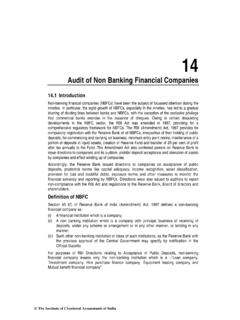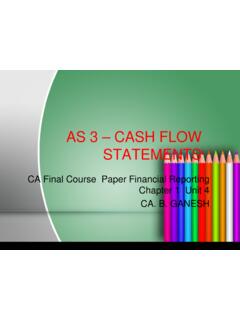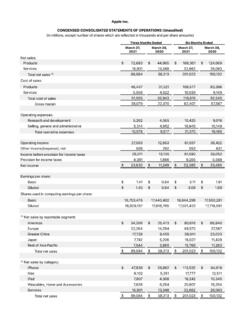Transcription of Consolidated Financial Statements of Group Companies
1 5 Consolidated Financial Statements of Group Companies UNIT 1 : INTRODUCTION Concept of Group , Holding Company and Subsidiary Company It is an era of business growth. Many organization are growing into large corporations by the process of acquisition, mergers, gaining control by one company over the other company, restructuring etc. Acquisition and mergers ultimately leads to either cost reduction or controlling the market or sharing the material supplies or product diversification or availing tax benefits or synergy. Whatever the motto behind these ventures is, the ultimate result is the large scale corporation. Formation of holding company is the most popular device for achieving these objectives. Group of Companies : Many a times, company expands by keeping intact their separate corporate identity. In this situation, a company (holding company) gains control over the other company (subsidiary company).
2 This significant control is exercised by one company over the other by- 1. Purchasing specified number of shares or 2. Exercising control over the board of directors or on voting power of that company. Unit of Companies connected in these ways is collectively called a Group of Companies . Holding Company and Subsidiary Company have been defined in Section 2 of the Companies Act, 2013 . Holding company: As per Clause 46 of Section 2 of the Companies Act, 2013, Holding company , in relation to one or more other Companies , means a company of which such Companies are subsidiary Companies . It may be defined as one, which has one or more subsidiary Companies and enjoys control over them. Legally a holding company and its subsidiaries are distinct and separate entities. However, in substance holding and subsidiary Companies work as a Group . Accordingly, users of holding company accounts need Financial information of subsidiaries to understand the performance and Financial position of the holding company.
3 Erstwhile Section 4 of the Companies Act, 1956. The Institute of Chartered Accountants of India Consolidated Financial Statements of Group Companies Subsidiary Company: According to Section 2(87) of the Companies Act, 2013 subsidiary company or subsidiary , in relation to any other company (that is to say the holding company), means a company in which the holding company (i) controls the composition of the Board of Directors; or (ii) exercises or controls more than one-half of the total share capital either at its own or together with one or more of its subsidiary Companies : Provided that such class or classes of holding Companies as may be prescribed shall not have layers of subsidiaries beyond such numbers as may be prescribed. Explanation. For the purposes of this clause, (a) a company shall be deemed to be a subsidiary company of the holding company even if the control referred to in sub-clause (i) or sub-clause (ii) is of another subsidiary company of the holding company; (b) the composition of a company s Board of Directors shall be deemed to be controlled by another company if that other company by exercise of some power exercisable by it at its discretion can appoint or remove all or a majority of the directors; (c) the expression company includes any body corporate.
4 Section 19 of the Companies Act, 2013 prohibits a subsidiary company from holding shares in the holding company. According to this section, no company shall, either by itself or through its nominees, hold any shares in its holding company and no holding company shall allot or transfer its shares to any of its subsidiary Companies and any such allotment or transfer of shares of a company to its subsidiary company shall be void: Provided that nothing in this section shall apply to a case (a) where the subsidiary company holds such shares as the legal representative of a deceased member of the holding co. (b) where the subsidiary company holds such shares as a trustee; or (c) where the subsidiary company is a shareholder even before it became a subsidiary company of the holding company: provided further that the subsidiary company referred to in the preceding provision shall have a right to vote at a meeting of the holding company only in respect of the shares held by it as a legal representative or as a trustee, But a subsidiary may continue to be a member of its holding company if it was a member thereof at the commencement of the Act or before becoming a subsidiary of the holding company.
5 In such a case, the subsidiary shall not have any voting rights in respect of the shares held. A Erstwhile Section 42(1) of the Companies Act, 1956. The Institute of Chartered Accountants of Financial Reporting subsidiary may also hold shares in the holding company as the legal representative of a deceased member of the holding company or as trustee (unless the holding company or any subsidiary thereof is beneficially interested under the trust concerned). Clause 55 of Section 2 of the Companies Act, 2013 gives following definition of member: member , in relation to a company, means (i) the subscriber to the memorandum of the company who shall be deemed to have agreed to become member of the company, and on its registration, shall be entered as member in its register of members; (ii) every other person who agrees in writing to become a member of the company and whose name is entered in the register of members of the company; (iii) every person holding shares of the company and whose name is entered as a beneficial owner in the records of a depository.
6 Wholly Owned and Partly Owned Subsidiaries A wholly owned subsidiary company (Example A ltd.) is one in which all the shares with voting rights of 100% are owned by the holding company (Example B Ltd.) In a partly owned subsidiary, all the shares of subsidiary company are not acquired by the holding company only the majority of shares ( , more than 50%) are owned by the holding company. In a wholly owned subsidiary, there is no minority interest because all the shares with voting rights are held by the holding company. On the other hand, in a partly owned subsidiary company, there is a minority interest because less than 50% shares with voting rights are held by outsiders other than the holding company. Purpose of Preparing the Consolidated Financial Statements Consolidated Financial Statements are the Financial Statements of a Group presented as those of a single enterprise, where a Group refers to a parent and all its subsidiaries.
7 Parent company needs to inform the users about the Financial position and results of operations of not only of their enterprise itself but also of the Group as a whole. For this purpose, Consolidated Financial Statements are prepared and presented by a parent/holding enterprise to provide Financial information about a parent and its subsidiary(ies) as a single economic entity. Consolidated Financial Statements are intended to show the Financial position of the Group as a whole - by showing the economic resources controlled by them, by presenting the obligations of the Group and the results the Group achieves with its resources. Erstwhile Section 41 of the Companies Act, 1956. The Institute of Chartered Accountants of India Consolidated Financial Statements of Group Companies Section 129(Clause 3) of the Companies Act, 2013 requires Companies compulsory to prepare Consolidated Financial Statements According to this section, where a company has one or more subsidiaries, it shall, in addition to separate Financial Statements will prepare a Consolidated Financial statement of the company and of all the subsidiaries in the same form and manner as that of its own which shall also be laid before the annual general meeting of the company, provided that the company shall also attach along with its Financial statement, a separate statement containing the salient features of the Financial statement of its subsidiary or subsidiaries in such form as may be prescribed.
8 Accounting Standard (AS) 21 also lays down principles and procedures for preparation and presentation of Consolidated Financial Statements . The International Accounting Standard 27 Consolidated Financial Statements and Accounting for Investments in Subsidiaries provides the basic framework for the preparation and presentation of Consolidated Statements as well as accounting for investments in subsidiaries in a parent s separate Financial Statements . Section 129 of the Companies Act, 2013 has not been notified by the Ministry of Corporate Affairs till 31st Dec., 2013. The Institute of Chartered Accountants of Financial Reporting UNIT 2 : Consolidated Financial Statements As per AS 21, Consolidated Financial Statements are the Financial Statements of a Group presented as those of a single enterprise.
9 The main advantages of consolidation are given below: (i) Single Source Document: From the Consolidated Financial Statements , the users of accounts can get an overall picture of the holding company and its subsidiaries. Consolidated Profit and Loss Account gives the overall profitability of the Group (ii) Intrinsic value of share: Intrinsic share value of the holding company can be calculated directly from the Consolidated Balance Sheet. (iii) Return on Investments in Subsidiaries: The holding company controls its subsidiary. So its return on investments in subsidiaries should not be measured in terms of dividend alone. Consolidated Financial Statements provide information for identifying revenue profit for determining return on investment. (iv) Acquisition of Subsidiary: The Minority Interest data of the Consolidated Financial Statement indicates the amount payable to the outside shareholders of the subsidiary company at book value which is used as the starting point of bargaining at the time of acquisition of a subsidiary by the holding company.
10 (v) Evaluation of Holding Company in the market: The overall Financial health of the holding company can be judged using Consolidated Financial Statements . Those who want to invest in the shares of the holding company or acquire it, need such Consolidated statement for evaluation. Requirements of Accounting Standard 21 Accounting Standard (AS) 21, Consolidated Financial Statements should be applied in the preparation and presentation of Consolidated Financial Statements for a Group of enterprises under the control of a parent. As per AS 21, Consolidated Financial Statements normally include Consolidated Balance Sheet Consolidated Statement of Profit and Loss Account Consolidated Cash Flow Statement (in case parent presents cash flow statement) Notes and Statements and explanatory schedules that form the integral part thereof. The Consolidated Financial Statements are presented to the extent possible in the same format as that adopted by the parent for its separate Financial Statements .













